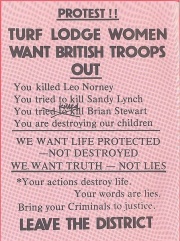Plastic bullet
The plastic bullet is the name given to a type of less-lethal projectile fired from a specialised gun, used in riot control. There are also some plastic bullets, such as those made by the bullet maker Speer, that are designed to be used for short range target practice.
Contents |
[edit] Crowd control use
[edit] Development
The bullet was developed by the British as the plastic baton round (PBR). It was intended to replace the older rubber bullet with a projectile that could be fired directly at targets while also reducing the risk of serious injury or death. It was introduced in 1972 and initially was used alongside the rubber bullet, which it replaced completely in 1975.
| ||||||||||||||||||||||||||||||||||||||||||||
[edit] Use in Northern Ireland
The first plastic bullet was made of PVC, was 89 mm (3.5 inches) long and 38 mm (1.5 in.) in diameter, and weighed approximately 142 g (5 oz.). The weight was similar to the rubber bullet but the new projectile had a lower muzzle velocity. From 1973 to 1981, over 42,000 plastic bullets were fired in Northern Ireland. Fourteen people were killed by plastic bullet impacts, including nine children. Most of the deaths were allegedly caused by the British security services misusing the weapon, firing at close range and at chest or head level rather than targeting below the waist.
A new round was introduced in 1994, the L5A7, along with a new weapon to fire it, the HK L104 antiriot gun. From the height of The Troubles, the use of the baton rounds declined. In 1999, 112 rounds were fired, compared to 8,300 in 1996, and there have been no deaths since 1989. 13,264 L5A7 rounds have been fired.
A further development of the round was introduced in Britain in 2001, the L21A1. Designed to be more accurate, the new acrylic round is also more capable of inflicting lethal injuries if it strikes a vital area.
[edit] Recreational use
Speer plastic bullets, the only widely available brand, are hollow based plastic cylinders, and are available in .357/.38/9 mm, .44, and .45 calibers, and are designed for use in handguns, primarily revolvers, as the flat nose of the bullet does not feed well in most magazine fed actions. The propulsion is provided only by the primer, and the slow moving plastic bullets may be captured undamaged and reused numerous times if a suitable backstop is used. For use in revolvers, .38 Special and .44 Special versions also include plastic cases, which can be primed and de-primed by hand with minimal tools. For other calibers, standard brass cases are used.[3]
[edit] See also
[edit] Notes and references
- ↑ The Royal Ulster Constabulary acquired plastic bullets in 1978, but the figures for 1978, 1979 and 1980 refer only to the number of plastic bullets fired by the army. The 1981 figures include plastic bullets fired by the RUC
- ↑ They Shoot Children: The use of rubber and plastic bullets in the north of Ireland, Published by Information on Ireland, Ivor Place, London.
- ↑ SPEER® Specialty Products Speer
[edit] External links
- Plastic Bullets-Relatives for Justice: Details the use of Plastic Bullets in Northern Ireland against the civilian populations and deaths resulting from their use
